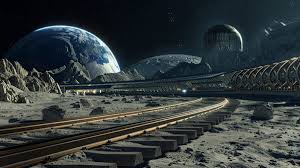NASA Announces Plan to Build First Railway System on Moon
NASA, the renowned space exploration agency, has recently made headlines with its groundbreaking announcement of plans to construct the first-ever railway system on the moon. This ambitious endeavor marks a significant leap forward in humanity’s quest for lunar exploration and colonization.
The proposed railway system, dubbed the Lunar Train, aims to revolutionize transportation infrastructure on the moon by providing a reliable and efficient means of traversing its rugged terrain. With the increasing interest in lunar missions and the prospect of establishing a sustainable human presence on the moon, the development of such infrastructure is crucial for enabling future exploration and resource utilization.
The Lunar Train project is part of NASA’s Artemis program, which seeks to return astronauts to the moon by the mid-2020s and establish a sustainable human presence there by the end of the decade. By laying the groundwork for a robust transportation network, NASA hopes to facilitate various scientific endeavors, resource extraction activities, and ultimately, the establishment of lunar habitats.
This initiative underscores NASA’s commitment to pushing the boundaries of space exploration and paving the way for future generations to explore and inhabit celestial bodies beyond Earth. The construction of a railway system on the moon represents a monumental engineering challenge, requiring innovative solutions to overcome the unique challenges posed by the lunar environment.
As NASA embarks on this ambitious venture, it will collaborate with international partners, private companies, and academic institutions to harness the collective expertise and resources needed to realize the vision of a lunar railway system. Through collaboration and innovation, humanity stands poised to take its next giant leap toward the stars.

Why this News is important:
Revolutionizing Lunar Transportation: NASA’s announcement of plans to build the first railway system on the moon signals a paradigm shift in lunar exploration and colonization efforts. By introducing a reliable and efficient means of transportation, the Lunar Train project aims to revolutionize how we navigate the lunar surface, facilitating future missions and resource utilization.
Enabling Sustainable Lunar Presence: The development of infrastructure such as the Lunar Train is essential for establishing a sustainable human presence on the moon. By providing a vital link between lunar habitats, research facilities, and resource extraction sites, the railway system will enable astronauts to traverse the lunar landscape with greater ease and efficiency.
Advancing Scientific Discovery: The construction of a railway system on the moon opens up new opportunities for scientific exploration and discovery. By facilitating access to diverse lunar environments, the Lunar Train will enable scientists to conduct research across a range of disciplines, from geology and astronomy to biology and planetary science.
Fostering International Collaboration: NASA’s ambitious plans for lunar exploration underscore the importance of international collaboration in space exploration endeavors. The Lunar Train project will involve cooperation between NASA, international space agencies, private companies, and academic institutions, harnessing the collective expertise and resources of the global community.
Inspiring Future Generations: The announcement of plans to build a railway system on the moon captures the imagination of people around the world, inspiring curiosity and excitement about the possibilities of space exploration. By pushing the boundaries of human ingenuity and exploration, NASA’s initiative serves as a beacon of hope for future generations of scientists, engineers, and explorers.
Historical Context:
Space Exploration Milestones: Humanity’s fascination with space exploration dates back to ancient times, but significant milestones in the modern era include the launch of the first artificial satellite, Sputnik 1, by the Soviet Union in 1957, and the historic Apollo 11 moon landing in 1969. These achievements paved the way for subsequent missions to the moon and beyond.
International Cooperation in Space: In recent decades, space exploration has increasingly become a collaborative effort involving multiple countries and organizations. Initiatives such as the International Space Station (ISS) highlight the importance of international cooperation in advancing scientific research and exploration beyond Earth’s atmosphere.
Technological Advancements: Advancements in space technology have played a pivotal role in enabling ambitious missions to explore the moon and other celestial bodies. From the development of powerful rockets to the creation of advanced robotics and autonomous systems, these technological innovations continue to push the boundaries of what is possible in space exploration.
Economic Opportunities in Space: In addition to scientific and exploration objectives, there is growing interest in the economic potential of space exploration and exploitation. The prospect of mining valuable resources such as water ice on the moon has spurred investment and research into technologies for lunar resource utilization.
Vision for Future Space Exploration: NASA’s announcement of plans to build a railway system on the moon reflects a broader vision for the future of space exploration, one that involves sustained human presence beyond Earth’s orbit. By laying the groundwork for infrastructure on the moon, NASA is taking concrete steps toward realizing this vision and opening up new frontiers in space.
Key Takeaways from “NASA Announces Plan to Build First Railway System on Moon”
| Serial Number | Key Takeaway |
|---|---|
| 1 | NASA plans to construct the first railway system on the moon as part of its Artemis program. |
| 2 | The Lunar Train project aims to revolutionize lunar transportation infrastructure, enabling future missions and resource utilization. |
| 3 | The railway system will facilitate scientific exploration, international collaboration, and the establishment of a sustainable human presence on the moon. |
| 4 | NASA will collaborate with international partners, private companies, and academic institutions to realize the vision of a lunar railway system. |
| 5 | The announcement reflects humanity’s ongoing commitment to pushing the boundaries of space exploration and inspiring future generations of scientists and explorers. |
Important FAQs for Students from this News
1. How will the Lunar Train project benefit future lunar missions?
- Answer: The Lunar Train project aims to revolutionize lunar transportation infrastructure, providing a reliable and efficient means of traversing the moon’s rugged terrain. This will facilitate future missions by enabling easier access to diverse lunar environments and resource extraction sites.
2. What is the significance of NASA’s Artemis program in relation to the Lunar Train project?
- Answer: NASA’s Artemis program is focused on returning astronauts to the moon and establishing a sustainable human presence there. The Lunar Train project is part of this broader initiative, laying the groundwork for infrastructure that will support long-term lunar exploration and colonization efforts.
3. How will the construction of a railway system on the moon contribute to international collaboration in space exploration?
- Answer: The Lunar Train project will involve collaboration between NASA, international space agencies, private companies, and academic institutions. This collaborative effort underscores the importance of international cooperation in advancing scientific research and exploration beyond Earth’s orbit.
4. What challenges does NASA face in building a railway system on the moon?
- Answer: Building a railway system on the moon presents unique engineering challenges, including the need to develop technologies capable of withstanding the harsh lunar environment and navigating its rugged terrain. NASA will need to innovate and collaborate with partners to overcome these challenges.
5. How does the announcement of plans to build a railway system on the moon inspire future generations?
- Answer: The announcement captures the imagination of people around the world, inspiring curiosity and excitement about the possibilities of space exploration. By pushing the boundaries of human ingenuity and exploration, NASA’s initiative serves as a beacon of hope for future generations of scientists, engineers, and explorers.
Some Important Current Affairs Links

















